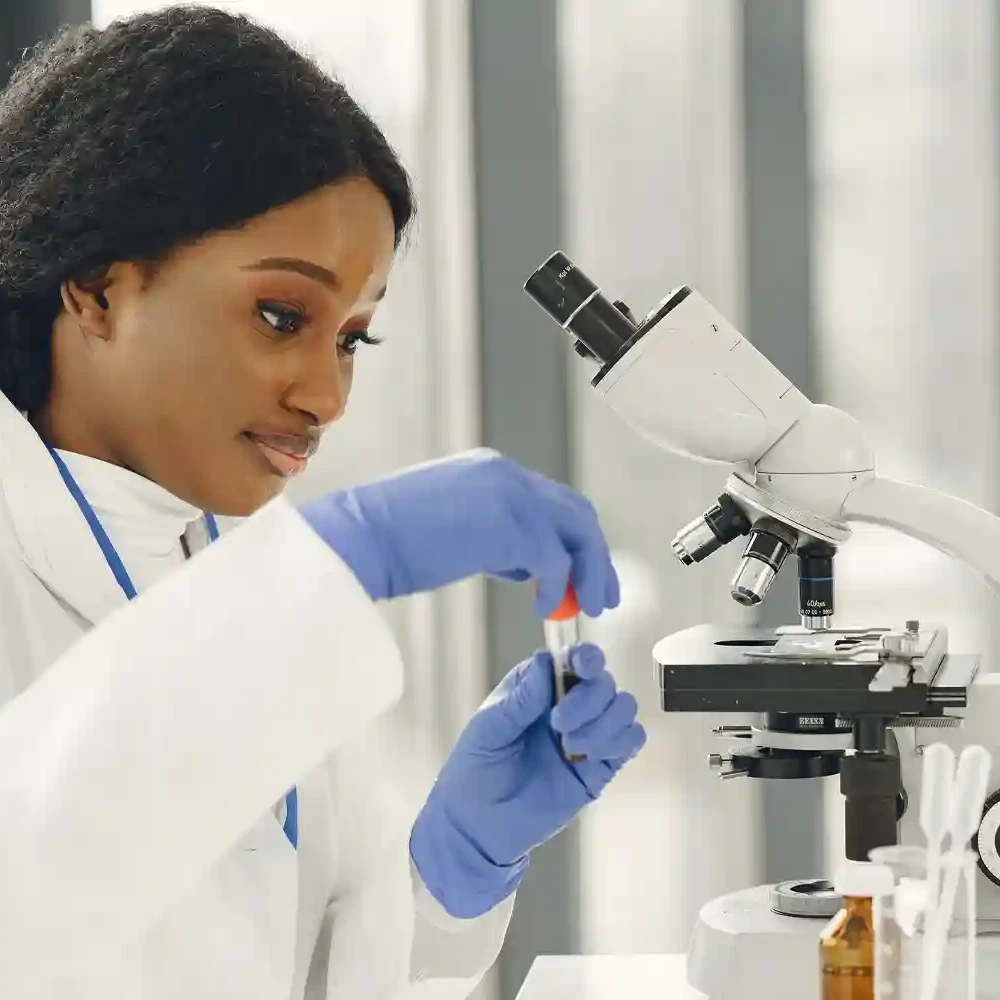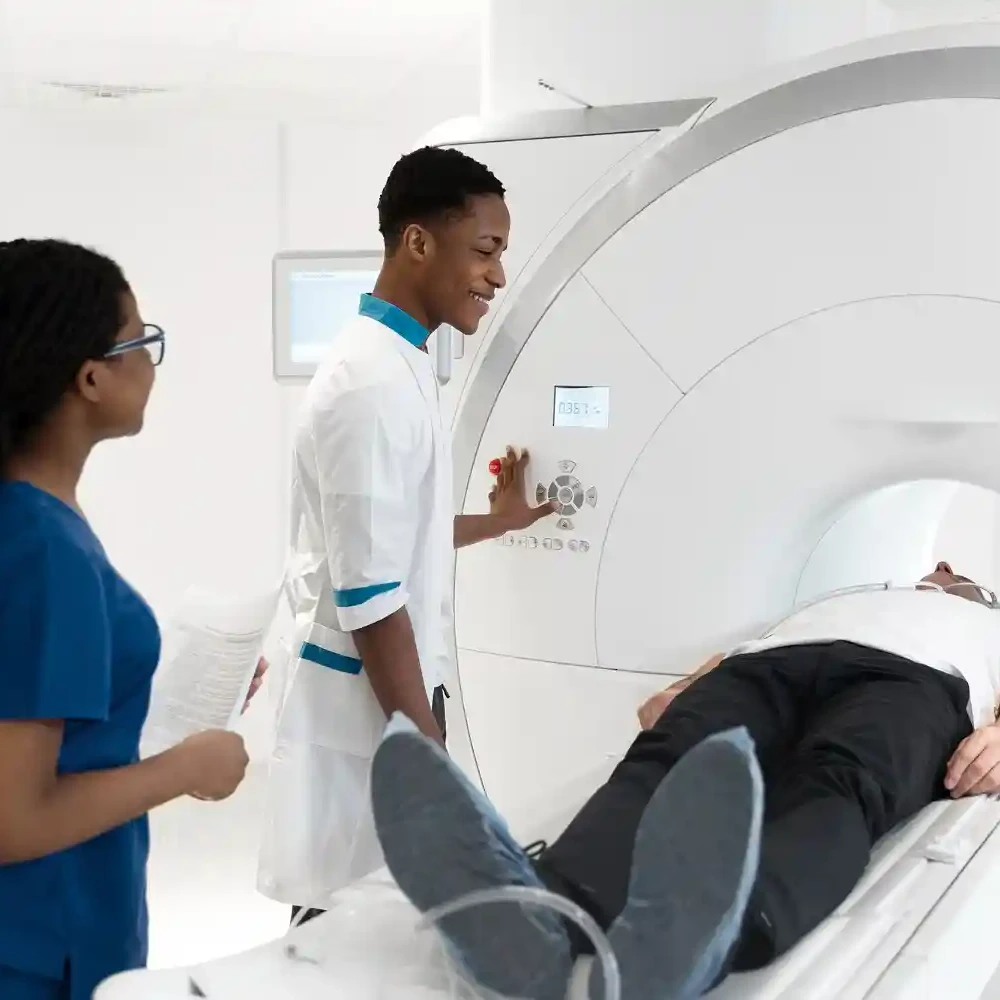Jump to...
- Fluoroscopy
- Reasons you might require the procedure
- What should you do before the procedure?
- How will the procedure be performed?
- Is the procedure painful?
- What should you do after the procedure?
- How will the result be interpreted?
- What are the risks and complications?
- How do you ensure low radiation exposure?
- Conclusion
Madam, we have to book you for a fluoroscopy, your doctor tells you.
Arrangements have been made, and you are informed that the examination is scheduled for the next morning.
Your doctor asks you to go and get prepared.
You left the doctor’s office with a feeling of nervousness and confusion.
Then, you quickly put a call across to your friend and ask
What is fluoroscopy?
First things first, you need not worry, as oftentimes, extra examinations that are not routine will need to be carried out to enable the doctor to efficiently and correctly diagnose your condition.
This is to prevent the wrong diagnosis and for your doctor to provide you with adequate treatment.
Fluoroscopy
Fluoroscopy is a test that uses X-ray imaging to make live-moving pictures of the body.
It is a video screen that allows your doctor to see how well your organs and tissues work, similar to watching a movie.
This is possible because of a device called a fluoroscope, which consists of a fluorescent screen and an X-ray beam that passes through your body, creating an image that reflects on a detector.
This image is then displayed on a screen for viewing by the doctor.
This may be performed to look at specific areas of the body, like the joints, muscles, bones, and organs like the kidneys or heart.
For example, it allows your doctor to see the pumping action of your heart.
Reasons you might require the procedure
There are several reasons why your doctor would recommend a fluoroscopy.
Some of these are:
- to view and investigate your gastrointestinal tract (esophagus, stomach, small and large bowel) using barium enemas
- for orthopedic procedures (during the proper alignment of bones, the treatment of fractures, or the introduction of implants)
- to view your blood vessels and organs (known as angiography)
- to check the airway for breathing problems
- to show the shape, size, and capacity of the bladder and urethra (medically referred to as Voiding cystourethrogram, VCUG)
- during the introduction of a small electronic device (a pacemaker) in the chest that helps to control the heartbeat
- useful when trying to introduce a tube (catheter) into the body
There may be other reasons for a fluoroscopy to be recommended by your doctor.
The type of fluoroscopy you receive will depend on your condition and your doctor’s recommendation.
Although many diagnostic procedures, such as bone and chest X-rays, do not require any preparation, fluoroscopy does.
The specific type that your doctor recommends will determine the necessary preparations required before undergoing the procedure
What should you do before the procedure?

Adequate preparations before a fluoroscopy procedure will ensure that you are comfortable and safe during the procedure.
By preparing, you will be helping your doctor obtain the most accurate results.
Your doctor will tell you the best way to prepare for the test.
A few things to do:
- Avoid eating anything, and limit the number of liquids you drink the night before.
- On the day of the procedure, you may have to skip your regular morning medications, or you could take them with you, and your doctor will tell you what time is best to take them.
- Do not wear any jewelry or piercings; leave them at home.
- You might be asked to sign a consent form.
Note: If you are pregnant, inform your doctor and your doctor will come up with another option that is convenient for you.
If you are breastfeeding, let your doctor know, and you will be advised on what to do.
It is also very important to mention previous surgeries to your doctor, the presence of any implants, and if you are allergic to certain medications, contrast dyes, or iodine.
How will the procedure be performed?
There are different techniques, and it will depend on the particular procedure, although usually these are the steps:
- At the diagnostic department, you might be asked to remove your clothing and change into a medical gown, which you will be given.
- You may be given a contrast dye, which depends on the type of procedure. You could be asked to swallow; it might be given through an intravenous (IV) line in your hand or arm; or it could be an injection through the rectum (medically referred to as an enema). The contrast agent, which can dissolve in water, helps your doctor look at the internal structures and organs under examination.
- Your doctor may ask you to drink water during the test. You might be sitting or lying down; you may be asked to move some parts of the body; or you might be asked to hold your breath for some seconds during the procedure. Your doctor, a radiologist, or the assistant will be around during the procedure, which takes several minutes (30 minutes to several hours).
- If it is a procedure that requires the introduction of a tube or catheter insertion, for example, the doctor will insert a needle into your elbow or any other relevant site.
- Your doctor or radiologist will make use of a special X-ray device to produce images of the body structure that is of interest.
- If the doctor or radiologist is examining a joint, they are going to remove any fluid in the joint with a syringe before injecting the contrast dye. After that, you may be asked to move the joint for a few minutes. This is to enable the contrast to spread.
- The total time depends on the part of the body that your doctor is looking at and also the type of fluoroscopic procedure.
- When the procedure is completed, your doctor or the radiologist technician will remove the IV line.
Is the procedure painful?
Fluoroscopy is a non-invasive medical test that is generally painless.
Your comfort and relaxation are of the utmost importance, and care will be taken to ensure that.
The fluoroscopy scanner itself will not touch you, and it is not painful.
On the X-ray table, your positioning should not be painful or make breathing difficult.
For the IV contrast injection, you might feel a little pinch during IV insertion.
You may also feel a brief warm sensation after the contrast is injected.
You may feel a slight pressure in the rectum during the insertion of the enema tube and the injection of the contrast.
Procedures like injection into a joint, a vein, or an artery for angiography may cause little pain or discomfort.
In some situations, your doctor or radiologist will take the utmost care to make sure that you are comfortable, which could mean that you might have to be given local anesthesia or general anesthesia.
This is dependent on the specific procedure.
What should you do after the procedure?
After your test, you can change back into your clothes.
Your doctor will make sure you get the care you require.
Depending on the procedure, you may need several minutes to recover and then go on with your normal activities, or you may require additional time for recovery.
After a contrast enema, you might experience loose bowel movements (running stomach) that contain contrast for a day or two.
Inform your doctor if unusual stools last longer.
If any pain or discomfort continues, along with redness and/or swelling at the IV site, after you return home, you should quickly inform your doctor, as this could be an indication of an infection or a type of reaction.
How will the results be interpreted?

After the procedure, the radiologist will look through your fluoroscopy images and examine them, then discuss the findings with your doctor.
Your doctor will make further observations and discuss the results with you.
Your doctor will interpret the results of your fluoroscopy, including your physical examination, medical history, and other tests that you may have undergone.
Then, your doctor will decide on the treatment option that is best for you.
What are the risks and complications?
Complications arising from the test are not common; however, like every medical procedure, there are some risks.
There is a small chance that an individual exposed to radiation from fluoroscopy will develop cancer in the future.
Your doctor follows strict standards for X-ray techniques.
Allergic reactions to contrast dyes can occur, although they are quite rare.
Your doctor and the radiological team are prepared to handle allergic reactions.
If you are pregnant, your doctor will generally avoid using this procedure because radiation from fluoroscopy can cause birth defects.
This is why you must inform your doctor if you are pregnant.
How do you ensure low radiation exposure?
For procedures involving exposure to ionizing radiation, your doctor and the team will help reduce your degree of exposure and the risks involved by:
- Find out if you have had a similar test recently performed.
- Checking for an alternative test that does not make use of ionizing radiation and is capable of providing them with the information required.
- Ensuring that only the smallest possible radiation dose needed to obtain a good-quality image is used. Your doctor follows strict standards for X-ray techniques.
- Providing protective lead shields. This shields the rest of your body from radiation.
Conclusion
Adequate preparation before fluoroscopy will ensure you get quality therapy.
Your doctor wants to be sure that you get the best readily available treatment, and for that to happen, it might be necessary to perform a fluoroscopy for an accurate diagnosis.
Your condition after fluoroscopy and how quickly you recover will depend on your diagnosis and the type of procedure.
The benefits of an appropriate fluoroscopy procedure are greater than the small risk of radiation.
It is important to keep check-up appointments with your doctor after the fluoroscopy.
If you enjoyed this article and have a suggestion or question, drop a comment below.
Emmanuel Obinwa
Dr. Emmanuel Obinwa graduated from Vinnitsa National Medical University. He enjoys creating and developing health related contents.



